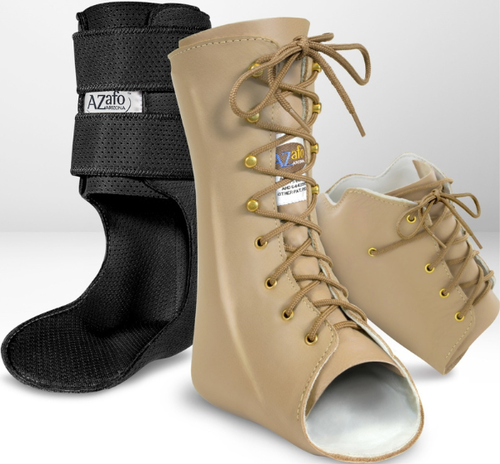You are probably familiar with the common birth injuries to mothers, such as a tear, damage to the pelvic floor, lacerations, and fractures.
But did you know that giving birth can also result in neurological problems?
If you’re having difficulty lifting the front part of your foot and toes, you may be suffering from drop foot due to nerve damage. Postpartum drop foot, caused by neurological injuries, has been associated with traumatic vaginal birth and difficult forceps deliveries.
Neuropathies during pregnancy and postpartum are common due to compression around pregnancy and childbirth. In some cases, our Arizona podiatrist says, nerve damage after pregnancy can lead to a drop foot, which though a symptom, can be debilitating.
This post will take a deep look at drop foot during and after pregnancy, including its causes, symptoms, and treatment options.
What Is Drop Foot?
Drop foot, sometimes called foot drop, is the inability to lift the front part of the foot. This causes you to involuntarily drag the toes of the affected foot while attempting to walk.
To avoid dragging the toes, you may lift your knees higher than normal, lose balance, or walk in an unsteady gait. Drop foot isn’t a disease. Rather, it’s a sign of an underlying neurological, anatomical, or muscular problem.
This foot condition can be very distressing. It’s more distressing, however, when it occurs as a complication of the puerperium of a healthy mother. In pregnant women, drop foot occurs due to injuries to the peripheral nerves of the lower extremities during labor.

What Causes Drop Foot?
In most cases, drop foot results from these three causes:
- Nerve injury
- Muscle disorders
- Brain or spinal disorders
Nerve Injury
The most common cause of a drop foot is an injury to the peroneal nerve. The peroneal nerve controls the muscles involved in lifting the foot. Some common ways peroneal nerve is damaged or compressed include:
- Childbirth
- Sports injuries
- Knee or hip replacement surgery
- Spending long hours squatting
Pregnant women and people with diabetes are more susceptible to nerve disorders associated with drop foot.
Muscle Disorder
Various forms of muscular dystrophy, a group of genetic diseases that cause weakness and loss of muscle mass, can contribute to a drop foot. Other conditions like polio that cause the muscles to progressively weaken can also be the culprit.
Brain or Spinal Disorders
Disorders that affect the brain or spinal cord—such as stroke, cerebral palsy, multiple sclerosis (MS), or amyotrophic lateral sclerosis (ALS) can also cause drop foot.
Why Can Drop Foot Occur After Childbirth?
As mentioned, the peroneal nerve, which runs from the back of the knee to the front of the shin, is mostly associated with a drop foot.
This nerve can easily get damaged or compressed during childbirth. Pregnant women can easily damage this nerve when pushing down hard during childbirth. And injuring this nerve can result in neuropathy disorders, including drop foot.
Also, pregnant women undergo significant strain on their bodies from carrying a baby for nine months, especially in the last stages of pregnancy as the baby grows heavier. The prolonged compression can also lead to nerve damage.
In the event you feel numbness or tingling pain in your feet after giving birth, contact your podiatrist right away. As with any other condition, early detection and treatment are key to recovery. Depending on the severity of your symptoms, your doctor may recommend surgical or non-surgical treatment (discussed below).
What are the Symptoms of Drop Foot?
People who have a drop foot may drag their toes when they walk. They may also raise their thighs when walking as though climbing stairs in an attempt to simulate a usual gait. In some cases, you might experience numbness on your feet and toes.
Other symptoms of drop foot include:
- Inability to hold footwear
- Circumduction gait
- High steppage gait
- Limp foot
- Tripping and falls
- Loss of balance
- Decrease in muscle mass (due to conditions such as multiple sclerosis)
Although the symptoms can be permanent, most drop foot cases resolve in two to six months.
What are the Treatment Options?
Drop foot is usually diagnosed through a physical exam.
Your doctor will observe you as you walk and check for signs of weaknesses, which could point to a problem with your nerves or muscles. They may also run imaging tests such as X-rays, CT scans, MRI, or ultrasound to pinpoint these problems.
Once your doctor identifies the underlying cause of your drop foot, they may recommend a non-surgical or surgical procedure.
Non-Surgical Treatment
For non-severe cases, your doctor will often opt for non-surgical treatment. Non-surgical treatments for drop foot include:
- Nerve stimulation
- Physical therapy
- Braces or splints
- Custom Orthotics
Surgical Procedure
Depending on the cause, surgery may be effective.
If your drop foot is severe and/or long-standing, your doctor might suggest surgery that fuses foot or ankle bones or a surgical procedure to fix the affected muscles and tendons. However, surgery should be the last resort for muscle injuries.




